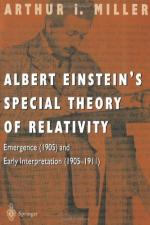|
This section contains 1,122 words (approx. 4 pages at 300 words per page) |

|
Einstein's Special Theory of Relativity
Summary: Introduced in 1905, Albert Einstein's Special Theory of Relativity is based on two ideas: the law of physics is constant for anyone moving at a constant speed, and the speed of light is constant for anyone, in any frame of reference. If the speed of light is constant, then time and space must be relative. The consequences of this constancy are time dilation, length contraction, mass change, and the equivalence between mass and time. Results of experiments throughout the twentieth century have served to support the validity of this theory.
Einstein's Special Theory of Relativity introduced in 1905 had changed our Newtonian understanding of time, space and motion. In his theory, he came up with two ideas. The first idea was that the law of physics are constant for anyone that is moving at a constant speed. The second idea was that the speed of light was constant for anyone, in any frame of reference. By extending this theory further, Einstein proposed that space and time are relative; that we should not treat time and space differently, but see it as space-time. No experiment has proved the theory of special relativity, but many have been is consistency with it.
From the special theory of relativity, if the speed of light is constant, then time and space must be relative. This can be derived from the formula S = d/t. If the speed is constant, then it must the distance...
|
This section contains 1,122 words (approx. 4 pages at 300 words per page) |

|


